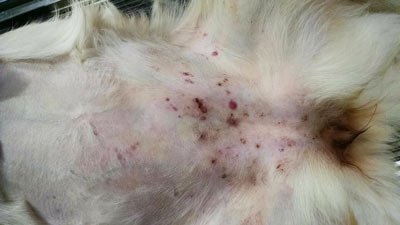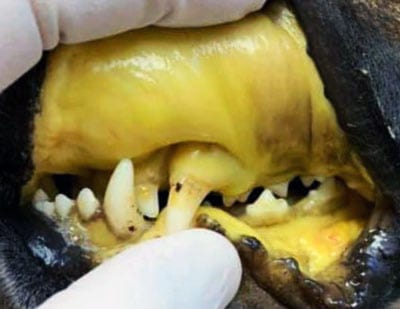Signs And Symptoms Of Poisoning In Dogs

[easy-social-share]
The thought that your dog might have been poisoned is distressing.
For many, our thought process wonders if that grumpy neighbour has poisoned our dog.
Sadly, every year several thousand dogs die from accidental poisoning with early symptoms and signs often being missed until it is too late to save them.
We want to help you to recognise the early and different symptoms your dog might have when they have been poisoned, and what to do to treat them if this happens.
In short, the signs and symptoms of poisoning in dogs and cats could include:
- Vomiting and/or diarrhoea
- Wobbliness leading to tremors and seizures
- Bleeding or bruising
- Restlessness
- Change in colour of their mucous membranes – eyes and gums and skin
If you prefer to watch a video, Dr Leigh discusses signs and symptoms of poisoning in dogs in this video.
How To Tell If A Dog Has Been Poisoned?
It can be difficult to give an exact answer to this question.
Poisons can affect different body systems and consequently, the effects they have on the body are different:
- Poisons that affect the Gastrointestinal system can cause
- vomiting
- drooling
- diarrhoea
- retching/gagging
- oral irritation
- Poisons that affect the cardiovascular system
- elevated or decreased heart rate
- elevated or decreased respiratory rate
- elevated or decreased blood pressure
- Poisons that affect the liver and/or kidneys
- kidney failure
- liver failure
- Poisons that affect the skin
- irritation and itch – dermatitis
- hairloss
- swelling, redness
- 2° photosensitisation
- Poisons that affect the neurological system
- agitation
- wobbliness
- tremors
- convulsions
Obviously, not all poisons and toxins act the same way so symptoms will differ however there are general themes that can guide us to what the causative problem may be.
And we need to remember that there are many potential poisons that can affect our pets, found in many different places:
- those in the garden
- in our homes
- certain foods
- medications
If you haven’t already, make sure you check out our article about the common cat and dog poisons to learn what toxins you should make sure to keep out of reach of your pets.
Common toxic substances that we see include dogs eating mushrooms, dogs licking or eating rat bait or ant bait and in the colder regions dogs ingesting antifreeze that’s dripped from your vehicle.
When in doubt, contact our vets 24/7 to get a plan of action and determine whether it is best that you make your dog vomit.
Gastrointestinal Signs Of Poisoning

When a dog has consumed a toxic substance, vets will often induce vomiting to aid decontamination.
The most common symptom of many poisons is gastrointestinal signs such as drooling, regurgitation, vomiting and diarrhoea.
Yes, these signs can be caused by a number of things unrelated to poisoning, so the next question is – when do we need to become concerned that this is more than a simple stomach upset and take action?
If your dog is looking bright and alert, has only had a couple of vomits or diarrhoea bouts and is still acting pretty normal, then it’s highly unlikely that they have suffered from poisoning unless you’ve just witnessed them eat something they shouldn’t have.
If however, they are dull, and depressed and you see other things in their vomit and diarrhoea such as blood, seeds or a colour change (i.e. very yellow vomit) then it is worthwhile seeking vet advice as poisoning could be a possible cause.
Neurological Signs Of Poisoning
The next common group of signs that we see with poisonings are neurological symptoms.
This includes signs such as wobbliness, twitching, tremors, convulsions and seizures.
If you notice any of these signs, even if mild it is recommended that you contact a vet asap.
While not all these signs mean it must be poisoning, you don’t want these symptoms to progress and they tend to progress quickly.
An example of a poisonous plant that produces neurological signs is Brunsfelsia (Yesterday, Today, Tomorrow).
All parts of the plant – flowers, leaves, stems and seeds are poisonous.
If you want more information about plants that are poisonous to pets we produced an in-depth guide for you to download.
Alterations To Blood As A Sign Of Poisoning
Blood problems are the next symptom that we commonly see with poisonings in particular with rat bait poisoning; one of the most common poisonings that vets see.
Changes to blood parameters and the associated symptoms may not be apparent for a couple of days after ingestion of the poison, so if you see these signs you must seek veterinary attention immediately.
Subtle signs that indicate that there is a problem with the blood that you might notice include:
- Lethargy
- Soft cough
- Increased respiratory rate, shallow breathing or increased effort
- Petechial haemorrhage – red spots on their belly and between their legs, white of eye
- Bleeding nose, gums, mouth
- Blood in their faeces or vomit
- Very pale gums
- Black tarry faeces
Like many things, it’s important to know what your dog’s normal vital signs are so that you can recognise when something is abnormal.

Red circular lesions indicate petechial haemorrhage. This is a common sign seen in dogs who have eaten rat bait.
Cardiovascular Symptoms Of Poisoning
The heart and lungs are another area that is often affected by poisons.
Heart Symptoms
Many poisons elevate the heart rate so that it is beating much faster than normal putting extra strain on this muscle.
The most common poison that does this is Chocolate!
Sometimes this increase in speed, combined with electrolyte imbalances in the blood leads to the heart beating erratically, otherwise known as having an arrhythmia.
Heart arrhythmia can be fatal by itself or it can result in reduced blood flow that can have knock-on effects on other organs such as kidneys.
Our article on how to do a physical examination on your pet has details of how to assess your dog’s heart rate.

Feel your dog’s heart rate on the left-hand side of the chest. Count how many beats occur in 15s and multiply by 4 to give the number of beats per minute.
Briefly, larger dogs have a lower heart rate while smaller dogs have a faster rate.
It’s best to learn what is normal for your dog so you can tell when you need to take action.
Most larger breed dogs have a HR from 60-100bpm while smaller dog breeds are 100-140bpm.
If your dog is experiencing rates higher than 140bpm at rest, they need to see a vet.
Your dog’s heart should also have a regular rhythm.
If it feels irregular, jumping all over the place and your dog is lethargic, it’s possible that they have an arrhythmia and it’s best to seek veterinary advice immediately.
Arrhythmias can be particularly nasty and result in sudden death.
Lungs: Changes To The Respiratory System
If the lungs are affected by a poison, then usually you will notice a fast breathing rate.
Again, it’s always good to know what normal is – so count the number of breaths in a minute.
Dogs that are relaxed and not panting normally have a breathing rate between 10 and 35 times per minute.
Sometimes we also notice that there is a lot of effort to breathe.
If your dog is struggling to breathe you may see a lot of abdominal movement.
They may move their elbows away from their body and stretch their neck out and breathe through their mouth.
This is in an attempt to aid the movement of air into their lungs.
If you notice any vital signs that suggest that your dog is struggling to breathe, GO TO THE VET ASAP
Poisoning Symptoms Related To Kidney And Liver
Kidney Symptoms
The kidneys and liver play a vital role in how a body removes toxins from the blood.
Many poisons are excreted via these organs and in the process cause irreparable damage to them resulting in organ failure.
Damage to the kidneys can occur very quickly and initially, the symptoms will seem very non-specific for poisoning such as:
- lethargy,
- perhaps they go off their food,
- they might have the occasional vomit.
Over the course of 24 hours, these signs often progress to an increase in drinking, but no increase in urination, more vomiting and then as it worsens your pet may just collapse.
Urine may also change colour.
Cats are particularly sensitive to toxins that affect the kidneys, lily toxicity being one of the most common illnesses seen.
Signs Of Liver Toxicity
Liver damage has similar symptoms, although you may also see the gums and whites of the eye turn a yellowish colour.

Jaundice (the yellow colour) can be a sign of poisoning in dogs.
Other Signs That Your Dog May Have Been Poisoned
Of course, there are many more signs that could indicate that your dog has been poisoned – things like hyperactivity, star gazing, vocalisation and fever to name just a few.
Bottom line, if you are concerned, your dog is behaving abnormally or their vital signs are not typical for them, get in touch with a vet.
What To Do If You Think Your Dog Has Been Poisoned
If you are worried that your dog has been poisoned it is far better to get in touch with our registered vets to determine if you need to get your dog to a clinic.
Timing is critical for the appropriate treatment of poisoning and often decontamination by inducing vomiting is all that is needed to save your dog from a life-threatening outcome.
We recommend:
- Remove your dog from the source of the toxin
- Immediately contact our vets for advice
- Keeping safe yourself, collect a sample of the poison or the packaging
- Go to the vet if required, keep calm
- Give the vet the packaging or sample
How Long Does It Take For Dog To Show Signs Of Poisoning
How quickly signs of toxicity occur in your dog will depend on the type and potency of the poison that they have come into contact with.
Some plant poisons that are ingested such as Yesterday Today Tomorrow, begin to show neurological tremor signs in dogs after about 4-6 hours.
Inhaled poisons can cause respiratory symptoms within minutes.
How To Stop A Dog From Being Poisoned
Like all these things prevention is far better than cure.
It’s wise to become familiar with the common poisons that can affect your dog and ensure that they have absolutely no access to them.
Invest in lockable cupboards or sheds so that it is impossible for your dog to open.
As always, if you have any questions or stories you’d like to share, pop them down in the comments section below. We’d love to hear all about them.
[easy-social-share]






CAN A DOG RECOVER FROM RAT POISON
Hello so my dog ate some rat poison,I’m not sure how much. I took him to the vet and they made him vomit. It was green. Will he be okay